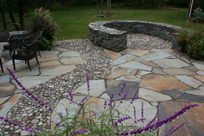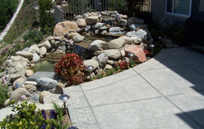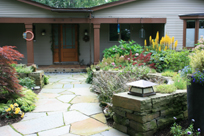Landscape, Plants, Hardscape & Decks
Once you start thinking along the lines of putting visual clutter out of sight, it’s as though a whole range of interesting concealment possibilities begin presenting themselves. Case in point: My early work in stashing hoses in buried utility boxes triggered thoughts about hiding other bits of deck “plumbing” that do a remarkable job of
Before I get to the meat of this series on using stone in landscapes and as part of aquatic environments, I must address an important concept having to do with how people have built with stone, both historically and in the here and now. The vast majority of stone walls and fences you see today – whether they were built 700 years ago or 70 – were
Stone. Rock. Boulder. Just the sounds of those words imply strength – terse terms that audibly capture gravity when pronounced. You expect the material they describe to be dominating, and in fact it does command attention, demand recognition and push us toward respect. We want rock. We need rock. But why? Maybe it’s because
For years now, I have been fascinated by the lengths people are willing to go to avoid visual clutter.It all started before I was a watershaper – back in the days when a partner and I spent our time setting up high-tech security systems in the homes of well-to-do residents of Silicon Valley. As though it were yesterday, I remember a homeowner giving me a tour of her house and taking delight in asking me to
Once I’ve worked my way through traffic-related issues of patio design (see “Defining the Flow” in the November 9 edition), I turn my attention to an array of other factors that influence the space, starting with
At the same time I’m interviewing my clients about their patios and determining exactly what they want and how they plan to use them (see my article in the October 9 edition of WaterShapes EXTRA!), I’m already thinking about traffic flow. As I see it, this constitutes one of the keys to
Let’s start by assuming that the home’s stage is set – that the main entry has been well defined, clearly established and graciously appointed. Let’s further assume that friends are coming over and that the weather is nice. In these circumstances,
Among all of the creatures who haunt the dreams of watershapers, I can’t think of any worse than gophers — especially when those gophers collude with clients who also happen to be attorneys. Not long ago, I had the lovely experience of being abused by both — first on the job site by the small, fur-bearing rodents, then in court by
Last time, Bruce Zaretsky discussed the importance of making a good first impression with a home’s landscape, starting with defining a pathway to the main entry. Here, he picks up that discussion while setting a broader front-yard stage. Today’s homes have many entries: front doors, service entries, back doors, garage doors and more. As a landscape designer, it is always my goal to
“You only get one chance to make a first impression.” How many times have you heard that in your life? There’s a good reason for it: First impressions last – and that’s particularly true with a home. This is why real estate agents typically bring up “curb appeal” when advising clients about how to sell at the best price. Why? Because if prospective buyers drive up and sees a messy, weed-plagued yard, chances are good that they will simply roll on by. And even if they stop, the negative initial impression will be hard to shake as they






















